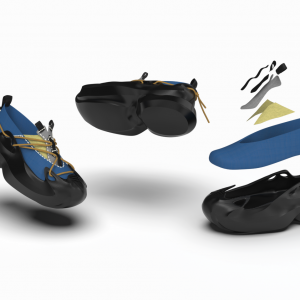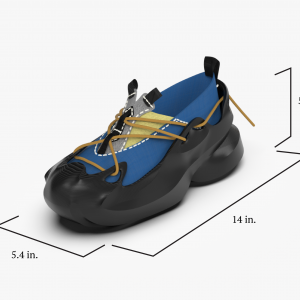Product Title: Navigating Sustainable Footwear Practices through Innovative Materials and Technology
Product Name: D.E.S.P 01 (Designed for Exploration in Sustainable Practices)
Topic/Problem:
Sophomore year I became passionate about footwear design. Shortly after, I realized the amount of plastic used in the components of a sneaker. After researching how sneakers and the industry affected the environment, I was very displeased at what I came across.
According to Jennifer Chu, a pair of running shoes generates 30 pounds of carbon dioxide emissions, equivalent to keeping a 100-watt light bulb on for one week. Additionally, more than 20 billion pairs of shoes are manufactured every year, with most pairs ending up in a landfill (Chu, Footwear’s (carbon) footprint).
For many years, the sneaker industry has contributed to a great deal of pollution in our environment. It is time for creatives and others alike, to take the initiative in creating better products that protect our world and improve our lives. Rethinking aspects such as materials, production, construction methods, etc. we can change the future of footwear. With new technologies and innovations, a more sustainable footwear industry is not far off.
With these factors in mind, how might I explore innovations and environmental impacts in sustainable footwear to find new possible solutions through materials, technology, construction, and circularity?
Solution:
The solution presented revolves around the concept of Design for Disassembly. This shoe was specifically made to be taken apart easily with minimal components. Each component is attached with only stitching, no glue. Since there are no adhesives used, each component can be taken apart easily to be recycled, re-manufactured, or re-used. Using 3D printing technology, I printed a complete flexible TPU sole that can be remelted and reused. The 3D printed midsole is attached to the upper through loops in the midsole that is secured with laces.
Including biodegradable, recycled, and responsible materials in the upper makes each component special. They all offer different properties and sustainable characteristics, one material may be able to biodegrade while another could be recycled easily through remelting and reforming. I took this direction with my design so the whole assembly can be constructed and deconstructed without impacting the environment. With the material choices, I considered end-of-life, recyclability, and construction.
Together, D.E.S.P 01 is the first experiment that tackles innovation and environmental impacts in sustainable footwear through materials, technology, construction, and circularity. This is the first step in an ongoing exploration of experiments on this topic.
Reference:
Chu, J. (2013, May 22). Footwear’s (carbon) footprint. MIT News | Massachusetts Institute of Technology. Retrieved May 1, 2022, from https://news.mit.edu/2013/footwear-carbon-footprint-0522






